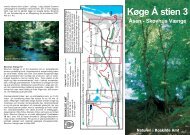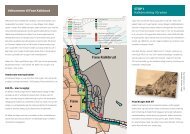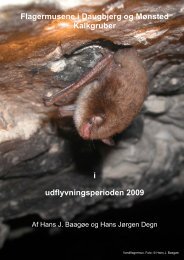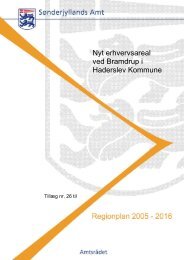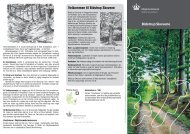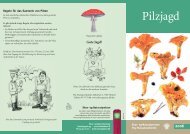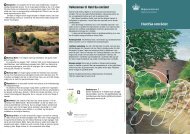Macroalgae and phytoplankton as indicators of ... - Naturstyrelsen
Macroalgae and phytoplankton as indicators of ... - Naturstyrelsen
Macroalgae and phytoplankton as indicators of ... - Naturstyrelsen
You also want an ePaper? Increase the reach of your titles
YUMPU automatically turns print PDFs into web optimized ePapers that Google loves.
3 <strong>Macroalgae</strong> <strong>as</strong> <strong>indicators</strong> <strong>of</strong> water<br />
quality<br />
3.1 Introduction<br />
Eutrophication is a major threat to submerged plant communities. Incre<strong>as</strong>ed<br />
nutrient richness stimulates the growth <strong>of</strong> planktonic algae <strong>and</strong><br />
thereby reduces water clarity <strong>and</strong> shades the benthic vegetation (e.g.<br />
Nielsen et al. 2002a). The shading effect may be further accentuated by<br />
epiphytic algae which also tend to proliferate under eutrophic conditions<br />
(Borum 1985). Lack <strong>of</strong> light reduces the depth penetration <strong>of</strong> benthic<br />
vegetation (Duarte 1991; Nielsen et al. 2002b) <strong>and</strong> also reduces vegetation<br />
abundance in the deeper, light limited waters (Duarte 1991; Dahl & Carstensen<br />
2008).<br />
Opportunistic <strong>and</strong> perennial macroalgal species may respond differently<br />
to changes in nutrient <strong>and</strong> light levels. Nutrient enrichment tends to<br />
stimulate the growth <strong>of</strong> opportunistic algae which then shade the perennial<br />
species (Littler & Littler 1980; Steneck & Dethiers 1994; Duarte 1995;<br />
Pedersen 1995). The abundance <strong>of</strong> opportunistic algae is therefore likely<br />
to incre<strong>as</strong>e at the expense <strong>of</strong> perennial algae <strong>as</strong> a function <strong>of</strong> incre<strong>as</strong>ed<br />
nutrient input. Moreover, the number <strong>of</strong> algal species may decline along<br />
a nutrient gradient (Middelboe et al. 1997).<br />
In our previous work for the Danish EPA we tested the response <strong>of</strong> Danish<br />
co<strong>as</strong>tal macroalgal communities to eutrophication <strong>and</strong> found that it<br />
to some extent followed the patterns outlined above (Carstensen et al.<br />
2005, Krause-Jensen et al. 2007a & b). The abundance <strong>of</strong> the macroalgal<br />
community <strong>as</strong> a whole <strong>as</strong> well <strong>as</strong> the abundance <strong>of</strong> perennial <strong>and</strong> opportunistic<br />
algae at given depths decre<strong>as</strong>ed significantly along a eutrophication<br />
gradient. By contr<strong>as</strong>t, the relative abundance <strong>of</strong> opportunists did not<br />
respond to changes in nutrient level, but instead responded to changes in<br />
salinity, being largest in the most brackish are<strong>as</strong>. These results indicate<br />
that at large geographical scales the marked salinity gradient <strong>of</strong> the Danish<br />
co<strong>as</strong>tal waters overrules possible effects <strong>of</strong> nutrients on the relative<br />
abundance <strong>of</strong> opportunists.<br />
Our previous studies <strong>of</strong> the co<strong>as</strong>tal Danish macroalgae thus strongly<br />
suggested that cover <strong>of</strong> the total macroalgal community <strong>and</strong> cover <strong>of</strong><br />
perennial macroalgae are useful <strong>indicators</strong> <strong>of</strong> water quality. However,<br />
there is a need to develop these <strong>indicators</strong> to become even more sensitive<br />
to changes in water quality, to define boundaries between ecological<br />
status cl<strong>as</strong>ses <strong>and</strong> to describe precisely how to use the <strong>indicators</strong> for <strong>as</strong>sessing<br />
water quality according to the WFD.<br />
For Spanish co<strong>as</strong>tal waters it h<strong>as</strong> been identified that not only the cover<br />
<strong>of</strong> characteristic algal species declines along a nutrient gradient, the<br />
number <strong>of</strong> the characteristic species also declines <strong>and</strong> the fraction <strong>of</strong> the<br />
total algal community made up by opportunistic algae incre<strong>as</strong>es along<br />
18




